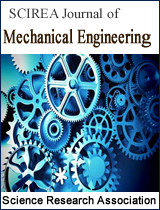An active forming grinding method for cylindrical involute gears based on a second-order transmission error model
DOI: 355 Downloads 113549 Views
Author(s)
Abstract
An active form-grinding method is proposed to obtain excellent and stable contact performance of cylindrical gears by designing modification forms based on a predesigned controllable second-order transmission error function. First of all, a predesigned second-order transmission error polynomial function is assigned to the gear drive. Mathematical models of modified tooth surfaces that can describe their local deviation and ease-off topography are then obtained with the predesigned second-order transmission error function. Moreover, the form-grinding wheel’s profile equation, the coordinate transformation matrix during form-grinding, and settings of computer numerical control form-grinding programs for this active design method can be determined. This approach is ultimately conducted on three involute cylindrical gear pairs to demonstrate its feasibility and effectiveness.
Keywords
Cylindrical gears; Second-order transmission error; Active design; Form-grinding
Cite this paper
Gang Li,
An active forming grinding method for cylindrical involute gears based on a second-order transmission error model
, SCIREA Journal of Mechanical Engineering.
Volume 2, Issue 1, February 2019 | PP. 1-14.
References
| [ 1 ] | Litvin, F.L. & Fuentes, A. 2004. Gear geometry and applied theory, 2nd edn. New York, NY: Cambridge University Press. |
| [ 2 ] | Li, G., Wang, Z. H., and Zhu, W. D., 2018, “Prediction of Surface Wear of Involute Gears Based on Revised Fractal Theory,” ASME Journal of Tribology, 141(3), p. 031603. |
| [ 3 ] | Litvin, F.L., Fuentes, A., & Hayasaka, K. 2006. Design, Manufacture, Stress Analysis, and Experimental Tests of Low-Noise High Endurance Spiral Bevel Gears. Mechanism and Machine Theory, 41(1): 83-118. |
| [ 4 ] | Lee, C. K. 2009. Manufacturing Process for a Cylindrical Crown Gear Derive with a Controllable Fourth Order Polynomial Function of Transmission Error. Journal of Materials Processing Technology, 209(1): 3-13. |
| [ 5 ] | Kolivand, M., & Kahraman, A. 2009. A load distribution model for hypoid gears using ease-off topography and shell theory. Mechanism and Machine Theory, 44(10): 1848–1865. |
| [ 6 ] | Fan, Q., DaFoe, R.S., & Swanger, J.W. 2009. Higher order tooth flank form error correction for face-milled spiral bevel and hypoid gears. Trans ASME Journal of Mechanical Design, 130(7): 072601. |
| [ 7 ] | Simon, V. 2009. Design and manufacture of spiral bevel gears with reduced transmission errors. Trans ASME Journal of Mechanical Design, 131(4): 041007. |
| [ 8 ] | Stadtfeld, H.J., & Gaiser, U. 2000. The ultimate motion graph. Trans ASME Journal of Mechanical Design, 122(3): 317-322. |
| [ 9 ] | Kato, S., & Kubo, A. 1999. Analysis of the effect of cutting dimensions on the performance of hypoid gears manufactured by the hobbing process. In: 4th World Congress on Gearing and Power Transmissions, Paris, France, March 1999, pp. 585–594. |
| [ 10 ] | Wang, P.Y., & Fong, Y.H. 2006. Fourth-order kinematic synthesis for face-milling spiral bevel gears with modified radial motion (MRM) correction. Trans ASME Journal of Mechanical Design, 128(2): 457–467. |
| [ 11 ] | Li, G., Wang, Z. H., Zhu, W. D., and Kubo, A., 2017, “A Function-Oriented Active Form-Grinding Method for Cylindrical Gears Based on Error Sensitivity,” International Journal of Advanced Manufacturing Technology, 92(5-8), pp. 3019–3031. |
| [ 12 ] | Li, G., Wang, Z. H., and Kubo, A., 2017, “Error-Sensitivity Analysis for Hypoid Gears Using a Real Tooth Surface Contact Model,” Proceedings of the Institution of Mechanical Engineers Part C - Journal of Mechanical Engineering Science, 231(3), pp. 507–521. |
| [ 13 ] | Li, G., Wang, Z. H., and Kubo, A., 2016, “The Modeling Approach of Digital Real Tooth Surfaces of Hypoid Gears Based on Non-Geometric-Feature Segmentation and Interpolation Algorithm,” International Journal of Precision Engineering and Manufacture, 17(3), pp. 281-292. |
| [ 14 ] | Artoni, A., Gabiccini, M., & Kolivand, M. 2013. Ease-off based compensation of tooth surface deviations for spiral bevel and hypoid gears: Only the pinion needs corrections. Mechanism and Machine Theory, 61: 84–101. |
| [ 15 ] | Liu, G.L., Chang, K., & Liu, Z.L. 2013. Reverse engineering of machine-tool setting with modified roll for spiral bevel pinion. Chin J Mech Eng-EN, 26(3): 573–584. |
| [ 16 ] | Gosselin, C., Shiono, Y., Kagimoto, H., & Aoyama, N. 1999. Corrective machine settings of spiral-bevel and hypoid gears with profile deviations. In: 4th World Congress on Gearing and Power Transmissions, Paris, France, pp. 543–555. |
| [ 17 ] | Simon, V. 2008. Influence of tooth errors and misalignments on tooth contact in spiral bevel gears. Mechanism and Machine Theory, 43(10): 1253–1267. |

